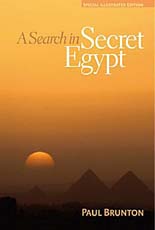Paul Brunton (1898-1981) was a pioneer in what Wayne Teasdale has called interspirituality. He published 11 book during his lifetime and is the author of the 16-volume posthumously-published Notebooks of Paul Brunton series in which he presents a world-encompassing spirituality. This lavishing book is a special illustrated edition of his 1936 book about his exploration of Egypt. Here for the first time are nearly 200 photographs and diagrams of Egypt's landscape, tombs, and temples.
Brunton's questing spirit makes this a fascinating read. A long meditation on the Sphinx leads him to embrace this monument as "the Silent Watcher of our world." He sees within him the strength of the lion, the intellect of a man, and the spiritual serenity of a god. Brunton's account of spending a night alone in the Great Pyramid is mesmerizing. He notes: "The mystery of the Great Pyramid is the mystery of the self. The lesson of the Pyramid is that man must turn inward, must venture to the unknown center of his being to find his soul, even if he must venture to the unknown depths of this fane to find its most profound secret." He also has some profound observations on the Osiris myth and the ancient mysteries.
Bruton's curiosity leads to interviews with Egypt's most famed fakir, a Muslim spiritual leader, and a snake-charmer. One of the most interesting aspects of the author's exposure to new experiences is his drastic change of attitude toward snakes:
"No longer did I fear each one as a creeping incarnation of treachery and deceit. Instead, I had slowly but increasingly come to feel a peculiar admiration for the sheen and sinuous beauty of their bodies and the graceful air of their upreared necks; a strange fascination for their undeniable weirdness and uncanny mystery; and a subtle sense of pity for them."
Paul Brunton models for us the inner work which is the true adventure of spiritual travel to faraway and exotic places. He demonstrates how these journeys can exercise our spirits and open us up to new possibilities.
